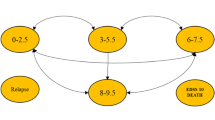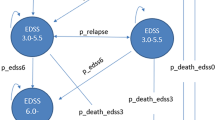Abstract
Background
Multiple sclerosis is the commonest cause of disability in young Irish adults. Natalizumab reduces disability progression in those patients with relapsing remitting multiple sclerosis who are suitable for it. First line disease modifying therapies are given in the community and are paid for by the hi-tech drug scheme. Natalizumab is given in hospital and is paid for from the hospital’s budget. Access to natalizumab has been problematic in some Irish hospitals. A budget impact analysis was performed to look at the overall cost to the Health Service Executive of giving natalizumab.
Methods
A budget impact analysis was performed from the perspective of the Health Service Executive comparing the use of natalizumab with first line disease modifying therapies for 2009–2011.
Results
The study showed that currently, the use of natalizumab is likely to be cost saving to the Health Service Executive overall, because some of the costs for natalizumab are borne by private insurers, whereas, all of the costs of disease modifying therapies are borne by the Health Service Executive.
Conclusions
Although the use of natalizumab is cost saving, current funding arrangements in the Health Service Executive do not allow for the transfer of money saved from drugs paid for in the hi-tech scheme, to hospitals who are supplying alternative treatments.
Similar content being viewed by others
Notes
Health Atlas Ireland is a collaboration of Population Health, HSE (Health Intelligence and HPSC), the School of Public Health and Population Sciences UCD and Dept of Geography, NUI, Maynooth providing access to “health mapping” across a sector through integrating geographical information systems, health datasets and statistical techniques. Funded by the Health Research Board and HPSC, it uses geocoded data from the Census, HIPE, mortality, infectious disease notifications, cancer registration, prescribing, disability and environmental data.
References
McGuigan C, McCarthy A, Quigley C, Bannan L, Hawkins S, Hutchinson M (2004) Latitudinal variation in the prevalence of multiple sclerosis in Ireland, an effect of genetic diversity. J Neurol Neurosurg Psychiatry 75(4):572–576
McDonnell G, Hawkins S (1998) An epidemiologic study of multiple sclerosis in Northern Ireland. Neurology 50(2):423–428
McGuigan C, Dunne C, Crowley J, Hagan R, Rooney G, Lawlor E et al (2005) Population frequency of HLA haplotypes contributes to the prevalence difference of multiple sclerosis in Ireland. J. Neurol 252(10):1245–1248
Central Statistics Office, Cork (2008) Regional population projections 2011–2026
Gray OM, McDonnell GV, Hawkins SA (2008) Factors in the rising prevalence of multiple sclerosis in the north-east of Ireland. Mult Scler 14(7):880–886
Mauskopf J, Sullivan S, Annemans L, Caro J, Mullins C, Nuijten M et al (2007) Principles of good practice for budget impact analysis: report of the ISPOR task force on good research practices-budget impact analysis. Value Health 10(5):336–347
Orlewska E, Mierzejewski P (2004) Proposal of Polish guidelines for conducting financial analysis and their comparison to existing guidance on budget impact in other countries. Value Health 7(1):1–10
Oturia A, Koch-Henriksen N, Petersen T, Jensen P, Sellebjerg F, Sorensen P (2009) Efficacy of natalizumab in multiple sclerosis patients with high disease activity: a Danish nationwide study. Eur J Neurol 16:420–423
Putzki N, Kollia K, Woods S, Igwe E, Diener H, Limmroth V (2009) Natalizumab is effective as second line therapy in the treatment of relapsing remitting multiple sclerosis. Eur J Neurol 16:424–426
Health Service Executive, Dublin (2007) Report on neurology and neurophysiology services. (Unpublished)
National Centre for Pharmacoeconomics, Dublin (2007) Economic evaluation of natalizumab (Tysabri) for the treatment of relapsing remitting multiple sclerosis that is rapidly evolving and severe or sub-optimally treated
Tappenden P, McCabe C, Chilcott J, Simpson E, Nixon R, Madan J et al (2009) Cost-effectiveness of disease-modifying therapies in the management of multiple sclerosis for the medicare population. Value Health 12(5):657–665
Author information
Authors and Affiliations
Corresponding author
Rights and permissions
About this article
Cite this article
Dee, A., Hutchinson, M. & De La Harpe, D. A budget impact analysis of natalizumab use in Ireland. Ir J Med Sci 181, 199–204 (2012). https://doi.org/10.1007/s11845-011-0773-6
Received:
Accepted:
Published:
Issue Date:
DOI: https://doi.org/10.1007/s11845-011-0773-6




